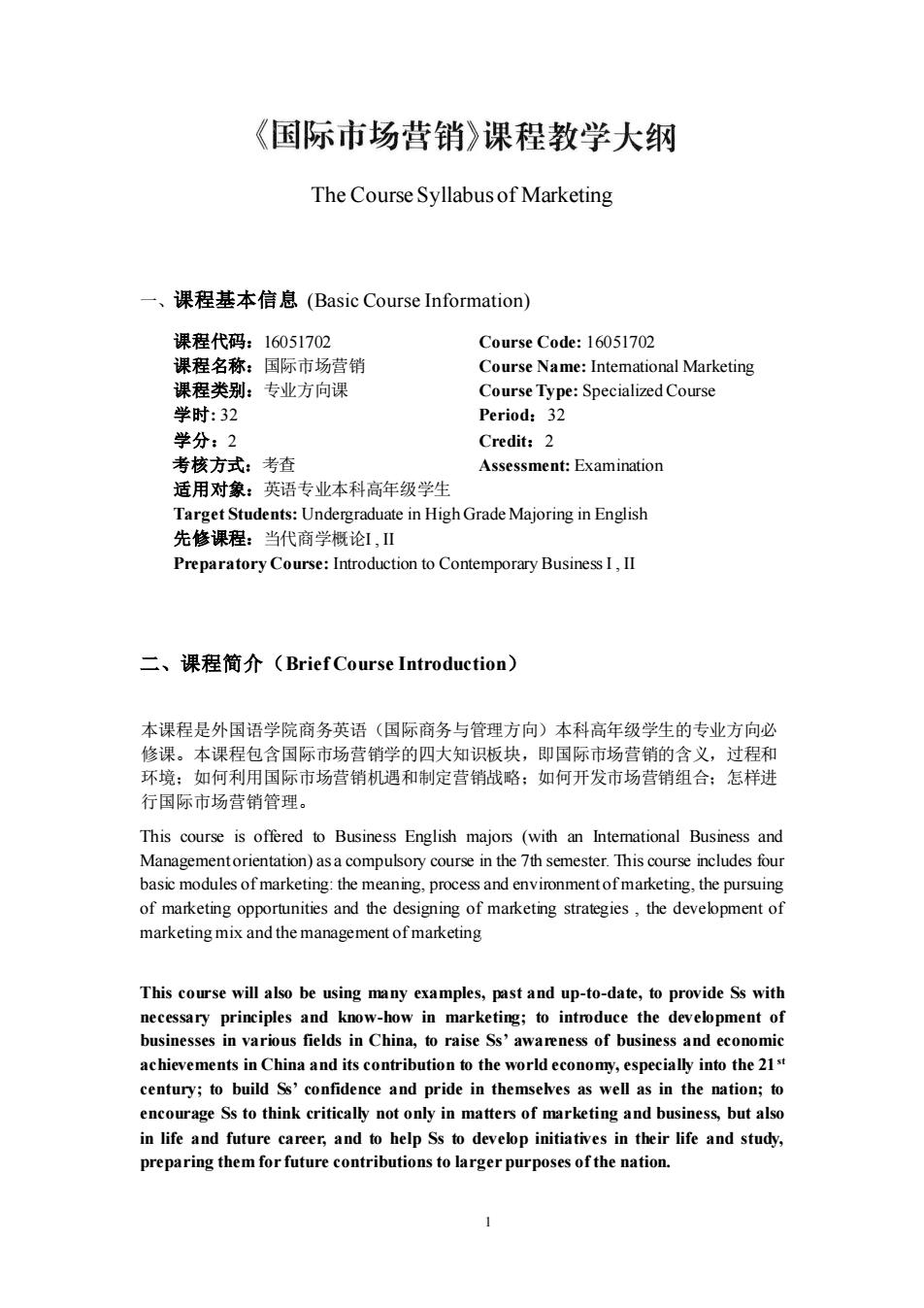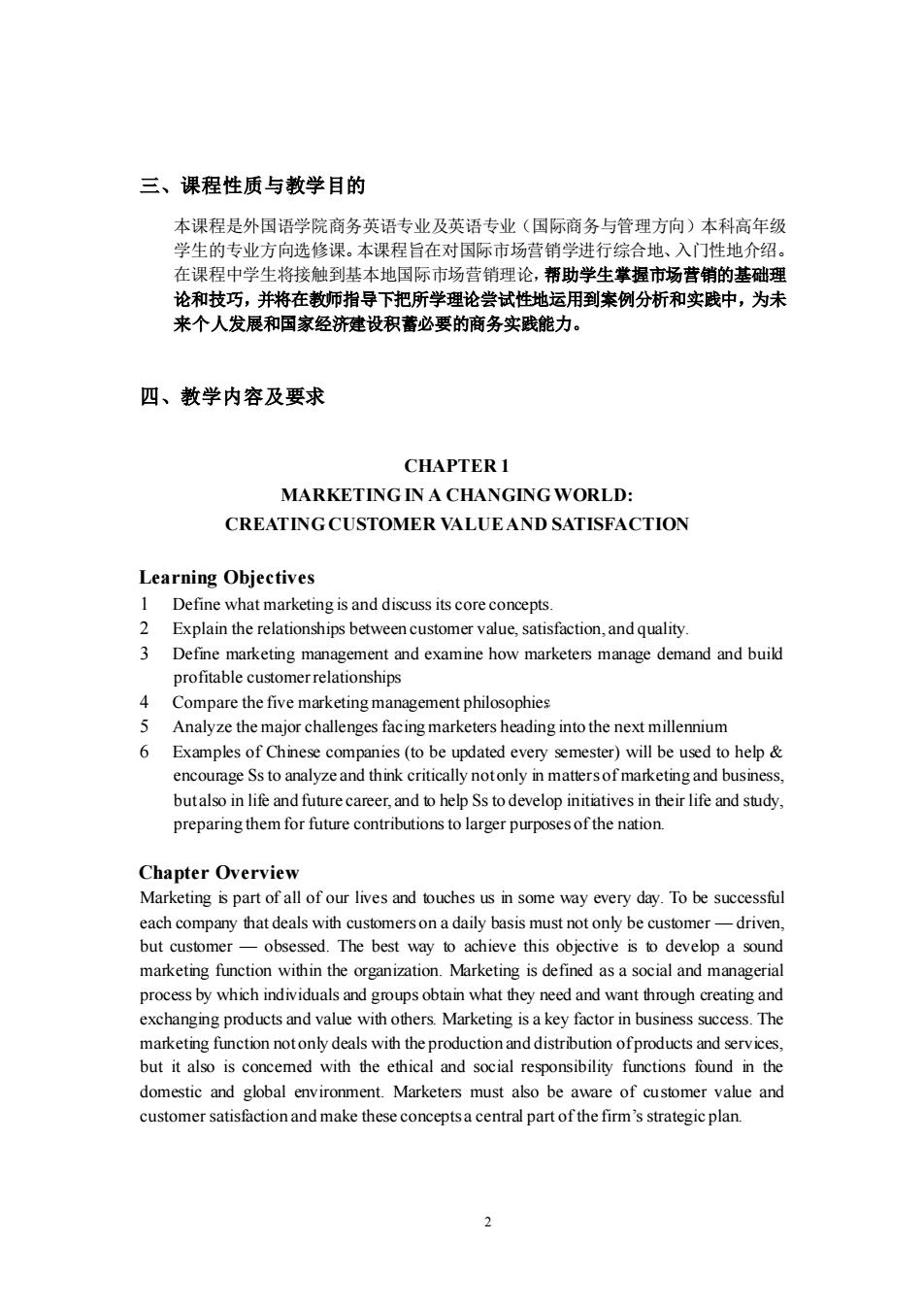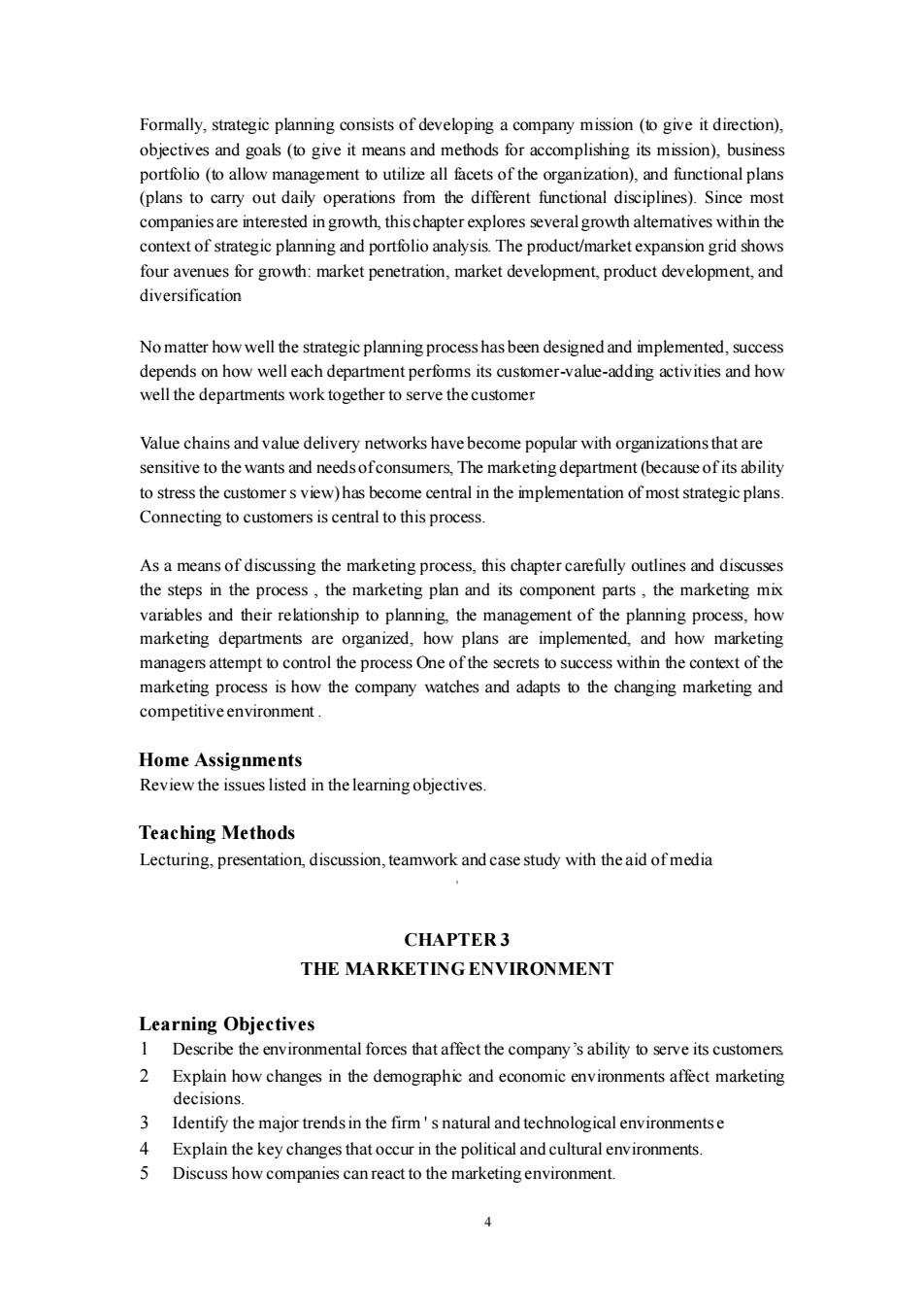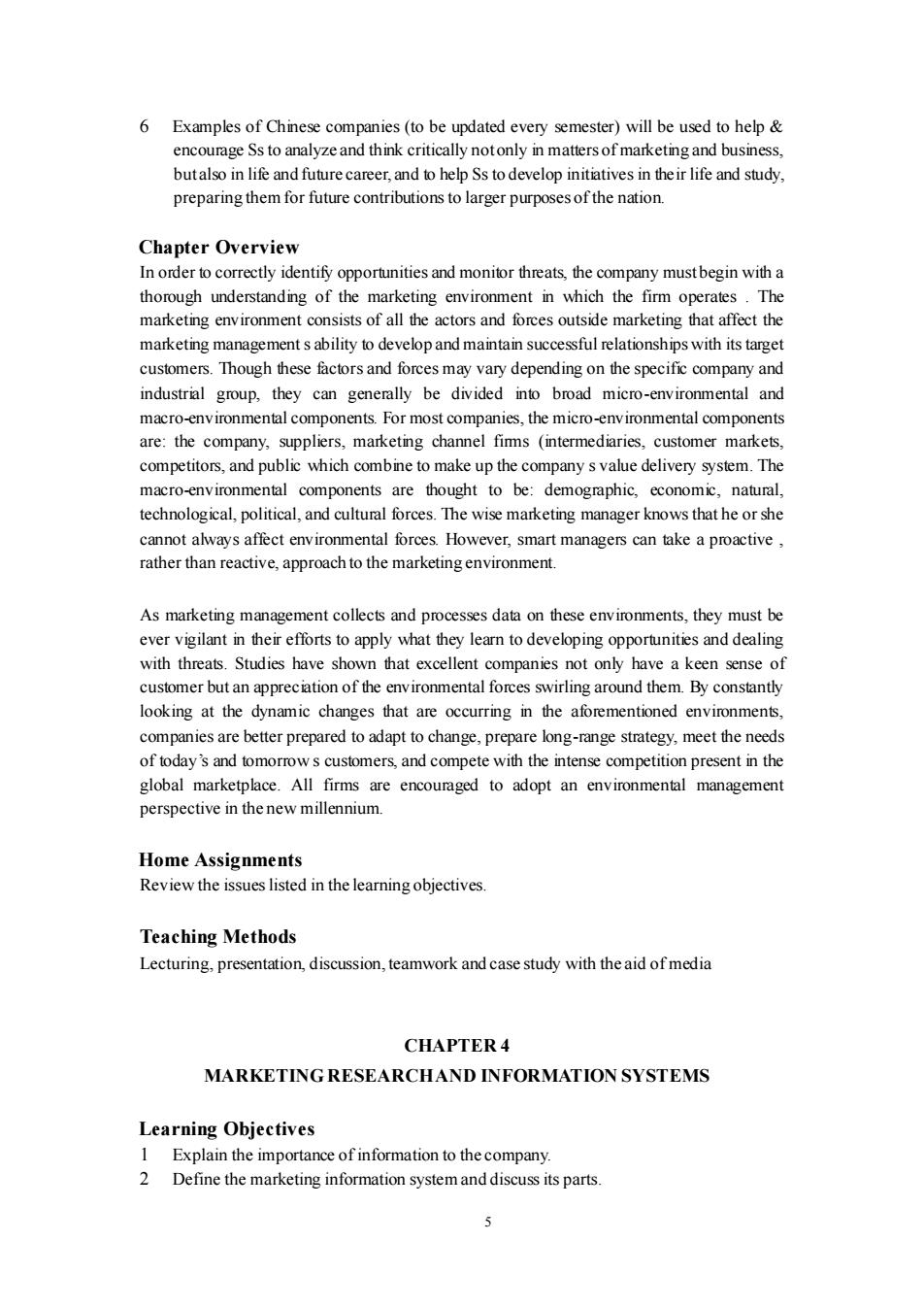
《国际市场营销》课程教学大纲 The Course Syllabus of Marketing 一、课程基本信息(Basic Course Information) 课程代码:16051702 Course Code:16051702 课程名称:国际市场营销 Course Name:Intemational Marketing 课程类别:专业方向课 Course Type:Specialized Course 学时:32 Period:32 学分:2 Credit:2 考核方式:考查 Assessment:Examination 适用对象:英语专业本科高年级学生 Preparatory Course:Introduction to Contemporary BusinessI,II 二、课程简介(BriefCourse Introduction) 本课程是外国语学院商务英语(国际商务与管理方向)本科高年级学生的专业方向必 修课。本课程包含国际市场营销学的四大知识板块,即国际市场营销的含义,过程和 环境:如何利用国际市场营销机遇和制定营销战略:如何开发市场营销组合:怎样进 行国际市场营销管理。 This course is offered to Business English majors (with an Inte ational Business s and Ma agementori nta basic modules of marketing:the meanng proceand environment of marketing,the pursuing of marketing opportunities and the designing of marketing strategies,the development of marketing mix and the management of marketing This course will also be sing many examples,past and up-to-date,to provide Ss with necessary principles and know-how in marketing;to introduce the development of businesses in various fields in China,to raise Ss'awareness of business and economic achievements in China and its contribution to the world economy,especially into the 21" century;to build Ss'confidence and pride in themselves as well as in the nation:to in life and future career,and to help Ss to develop initiatives in their life and study. preparing them for future contributions to larger purposes of the nation. 1
1 The Course Syllabus of Marketing 一、课程基本信息 (Basic Course Information) 课程代码:16051702 Course Code: 16051702 课程名称:国际市场营销 Course Name: International Marketing 课程类别:专业方向课 Course Type: Specialized Course 学时: 32 Period:32 学分:2 Credit:2 考核方式:考查 Assessment: Examination 适用对象:英语专业本科高年级学生 Target Students: Undergraduate in High Grade Majoring in English 先修课程:当代商学概论I , II Preparatory Course: Introduction to Contemporary Business I , II 二、课程简介(Brief Course Introduction) 本课程是外国语学院商务英语(国际商务与管理方向)本科高年级学生的专业方向必 修课。本课程包含国际市场营销学的四大知识板块,即国际市场营销的含义,过程和 环境;如何利用国际市场营销机遇和制定营销战略;如何开发市场营销组合;怎样进 行国际市场营销管理。 This course is offered to Business English majors (with an International Business and Management orientation) as a compulsory course in the 7th semester. This course includes four basic modules of marketing: the meaning, process and environment of marketing, the pursuing of marketing opportunities and the designing of marketing strategies , the development of marketing mix and the management of marketing This course will also be using many examples, past and up-to-date, to provide Ss with necessary principles and know-how in marketing; to introduce the development of businesses in various fields in China, to raise Ss’ awareness of business and economic achievements in China and its contribution to the world economy, especially into the 21st century; to build Ss’ confidence and pride in themselves as well as in the nation; to encourage Ss to think critically not only in matters of marketing and business, but also in life and future career, and to help Ss to develop initiatives in their life and study, preparing them for future contributions to larger purposes of the nation

三、课程性质与教学目的 本课程是外国语学院商务英语专业及英语专业(国际商务与管理方向)本科高年级 学生的专业方向选修课。本课程旨在对国际市场营销学进行综合地、入门性地介绍 在课程中学生将接触到基本地国际市场营销理论,帮助学生举握市场营销的基础理 论和技巧,并将在教师指导下把所学理论尝试性地运用到案例分析和实贱中,为未 来个人发履和国家经济建设积蕾必要的商务实践能力。 四、教学内容及要求 CHAPTERI MARKETING IN A CHANGING WORLD: CREATING CUSTOMER VALUEAND SATISFACTION Learning Objectives 1 Define what marketing is and discuss its core concepts 2 Define marketing management and examine how marketers manage demand and buil profitable customer relationships 4 Compare the five marketing management philosophies Analye the major challenges facing marketers heading into the next 6 Examples of Chinese companies(to be updated every semester)will be used to help& encourage Ss to analyze and think critically notonly in matters of marketing and business. butalso in life and future career,and to help Ss to develop initiatives in their life and study. preparing them for future contributions to larger purposesof the nation. Chapter Overview Marketing is part of all of our lives and touches us in some way every day.To be successful each company that deals with customers on a daily basis must not only be customer-driven but customer-obsessed.The best way to achieve this obiective is to develop a sound marketing functi within the organition.Marketing is defined as a social and managerial process by which individuals and groups obtain what they need and wanth ough creating an exchanging products and value with others.Marketing is a key factor in business success.The marketing function notonly deals with the production and distribution ofproducts and services but it also is concemed with the ethical and social responsibility functions found in the domestic and glbal environment.Marketers must akso be aware of customer value and customer satisfactionand make these conceptsa central part of the firm's strategic pla
2 三、课程性质与教学目的 本课程是外国语学院商务英语专业及英语专业(国际商务与管理方向)本科高年级 学生的专业方向选修课。本课程旨在对国际市场营销学进行综合地、入门性地介绍。 在课程中学生将接触到基本地国际市场营销理论,帮助学生掌握市场营销的基础理 论和技巧,并将在教师指导下把所学理论尝试性地运用到案例分析和实践中,为未 来个人发展和国家经济建设积蓄必要的商务实践能力。 四、教学内容及要求 CHAPTER 1 MARKETING IN A CHANGING WORLD: CREATING CUSTOMER VALUE AND SATISFACTION Learning Objectives 1 Define what marketing is and discuss its core concepts. 2 Explain the relationships between customer value, satisfaction, and quality. 3 Define marketing management and examine how marketers manage demand and build profitable customer relationships 4 Compare the five marketing management philosophies 5 Analyze the major challenges facing marketers heading into the next millennium 6 Examples of Chinese companies (to be updated every semester) will be used to help & encourage Ss to analyze and think critically not only in matters of marketing and business, but also in life and future career, and to help Ss to develop initiatives in their life and study, preparing them for future contributions to larger purposes of the nation. Chapter Overview Marketing is part of all of our lives and touches us in some way every day. To be successful each company that deals with customers on a daily basis must not only be customer — driven, but customer — obsessed. The best way to achieve this objective is to develop a sound marketing function within the organization. Marketing is defined as a social and managerial process by which individuals and groups obtain what they need and want through creating and exchanging products and value with others. Marketing is a key factor in business success. The marketing function not only deals with the production and distribution of products and services, but it also is concerned with the ethical and social responsibility functions found in the domestic and global environment. Marketers must also be aware of customer value and customer satisfaction and make these concepts a central part of the firm’s strategic plan

Marketing must also be aware ofand respond to change.Four of the greatest changes that have the computer,the Intemet telecommunications,and infommation technology.Marketing and it core concepts,the exchange relationship,the major philosophies of marketing thought and practice,and marketing challenges in the new connected'millennium are the major topics presented in this introductory chapter.There is a special emphasis on connected and the echnologies for accomplishing connections Home Assignments Review the issues listed in the learningobjectives. Teaching Methods Lecturing.presentation,discussion,teamwork and case study with the aid of different media CHAPTER2 STRATEGIC PLANNINGAND THE MARKETING PROCESS Learning Objectives 1 Explain company-wide strategic planningand its four steps Discuss how to design business portfolios and growth strategies 3 Explain functional planning strategies and assess marketing's role in strategic planning 4 Describe the marketing process and the forces that influence it. 5 6 Examples of Chinese companies(to be updated every semester)will be used to help& encourage Ss to analyze and think critically notonly in matters of marketing and business. butalso in life and future career,and to help Ss to develop initiatives in their life and study. oreparing them for future contributions to larger purposes of the nation. Chapter Overview To meet changing conditions in their industries.companies need to look ahead and develop long-term strategies.Strategc planning involves develop ing a strategy to meet insure lo ng-t and The marketing function plays ar important ole in this process in that it provides information and other inputs to help in the preparation of th organization s strategic plan. Strategic planning is described as the process of developing and maintaining a strategic fit between the organization s goals and capabilities and its changing marketing opportunities. Strategic planning sets the stage for the rest of the planning in the firm 3
3 Marketing must also be aware of and respond to change. Four of the greatest changes that have had an impact on the way companies bring value to their customers are the explosive growth of the computer, the Internet, telecommunications, and information technology. Marketing and its core concepts, the exchange relationship, the major philosophies of marketing thought and practice, and marketing challenges in the new connected ' millennium are the major topics presented in this introductory chapter. There is a special emphasis on connected and the technologies for accomplishing connections. Home Assignments Review the issues listed in the learning objectives. Teaching Methods Lecturing, presentation, discussion, teamwork and case study with the aid of different media CHAPTER 2 STRATEGIC PLANNING AND THE MARKETING PROCESS Learning Objectives 1 Explain company-wide strategic planning and its four steps. 2 Discuss how to design business portfolios and growth strategies. 3 Explain functional planning strategies and assess marketing’s role in strategic planning. 4 Describe the marketing process and the forces that influence it. 5 List the marketing management functions, including the elements of a marketing plan. 6 Examples of Chinese companies (to be updated every semester) will be used to help & encourage Ss to analyze and think critically not only in matters of marketing and business, but also in life and future career, and to help Ss to develop initiatives in their life and study, preparing them for future contributions to larger purposes of the nation. Chapter Overview To meet changing conditions in their industries, companies need to look ahead and develop long-term strategies. Strategic planning involves developing a strategy to meet competition and insure long-term survival and growth. The marketing function plays an important role in this process in that it provides information and other inputs to help in the preparation of the organization s strategic plan. Strategic planning is described as the process of developing and maintaining a strategic fit between the organization s goals and capabilities and its changing marketing opportunities. Strategic planning sets the stage for the rest of the planning in the firm

Formally,strategic planning consists of developing a company mission (to give it direction). nagement to utilize all facets of the (plans to carry out daily operations from the different fiunctional disciplines).Since mos companies are interested in growth,thischapter explores severalgrowth altematives within the context of strategic planning and portfolio analysis The product/market expansion grid shows No matter how well the strategic planning process has been designed and implemented.success Value chains and value delivery networks have become popular with organizations that are sensitive to the wants and needsofconsumers,The marketing department(because of its ability tostress the)has become central nhe implementation of most strategic plans. Connecting to customers is central to this process As a means of discussing the marketing process,this chapter carefully outlines and discusses the steps in the process,the marketing plan and its component parts,the marketing mix variables and their relationship to planning the management of the planning marketing departments implemer managers attempt to control the process One of the secrets to success within the context of th marketing process is how the company watches and adapts to the changing marketing and competitive environment Home Assignme Review the issues listed in the learningobjectives Teaching Methods Lecturing.presentation,discussion,teamwork and case study with theaid of media CHAPTER3 THE MARKETING ENVIRONMENT Learning Objectives Describe the environmental forces that affect the company's ability to serve its customers Explain how changes in the demographic and economic environments affect marketing decisions. 3 Identify the major trends in the firm's natural and technological environmentse Explain the key changes the political Discuss how companies can react to the marketing environmen 4
4 Formally, strategic planning consists of developing a company mission (to give it direction), objectives and goals (to give it means and methods for accomplishing its mission), business portfolio (to allow management to utilize all facets of the organization), and functional plans (plans to carry out daily operations from the different functional disciplines). Since most companies are interested in growth, this chapter explores several growth alternatives within the context of strategic planning and portfolio analysis. The product/market expansion grid shows four avenues for growth: market penetration, market development, product development, and diversification No matter how well the strategic planning process has been designed and implemented, success depends on how well each department performs its customer-value-adding activities and how well the departments work together to serve the customer Value chains and value delivery networks have become popular with organizations that are sensitive to the wants and needs of consumers, The marketing department (because of its ability to stress the customer s view) has become central in the implementation of most strategic plans. Connecting to customers is central to this process. As a means of discussing the marketing process, this chapter carefully outlines and discusses the steps in the process , the marketing plan and its component parts , the marketing mix variables and their relationship to planning, the management of the planning process, how marketing departments are organized, how plans are implemented, and how marketing managers attempt to control the process One of the secrets to success within the context of the marketing process is how the company watches and adapts to the changing marketing and competitive environment . Home Assignments Review the issues listed in the learning objectives. Teaching Methods Lecturing, presentation, discussion, teamwork and case study with the aid of media CHAPTER 3 THE MARKETING ENVIRONMENT Learning Objectives 1 Describe the environmental forces that affect the company’s ability to serve its customers 2 Explain how changes in the demographic and economic environments affect marketing decisions. 3 Identify the major trends in the firm ' s natural and technological environments e 4 Explain the key changes that occur in the political and cultural environments. 5 Discuss how companies can react to the marketing environment

6 Examples of Chinese comp nies(to be updated every semester)will be used to help encourage to analyze and think butalso in life and future career,and to help Ss to develop initiatives in the ir life and study. preparing them for future contributions to larger purposes of the nation. Chapter Overview mon reats he company mustbegin with a thorough understanding of the marketing environment in which the firm operates marketing environment consists of all the actors and forces outside marketing that affect the marketing management s ability to develop and maintain successful relationships with its target customers.Though these factors and forces may vary depending on the specific company and industrial group.they can generally be divided ino broad micr and macro-environmental components.For most companies,the micro- environmental components are:the company,suppliers.marketing channel fims (intermediaries,customer markets. competitors,and public which combine to make up the company s value delivery system.The macro-environmental components are thought to be:demographic.economic,natural. technological,political,and cultural forces.The wise marketing m nager knows that he or she cannot always affect environmental forces.However,smart managers can take a proactive. rather than reactive,approach to the marketing environment As marketin ent collects and proc s data on these environments,they must be ever vigilant in heir efforts to apply what they leam to developing opporunities and dealing with threats.Studies have shown that excellent companies not only have a keen sense of customer but an appreciation of the environmental forces swirling around them.By constantly looking at the dynamic changes that are occurring in the aforementioned environments. nies are better prepared to adapt to change.pre are long-range strategy,meet the needs ofoyad tomos cutmerand empete the eomp n present in the global marketplace.All firms are encouraged to adopt an environmental management perspective in the new millennium. Home Assignme Review the issues listed in the learning objectives Teaching Methods Lecturing,presentation,discussion,teamwork and case study with theaid of media CHAPTER4 MARKETING RESEARCHAND INFORMATION SYSTEMS Learning Objectives 1 Explain the importance of information to the company 2 Define the marketing information systemand discuss its parts 5
5 6 Examples of Chinese companies (to be updated every semester) will be used to help & encourage Ss to analyze and think critically not only in matters of marketing and business, but also in life and future career, and to help Ss to develop initiatives in their life and study, preparing them for future contributions to larger purposes of the nation. Chapter Overview In order to correctly identify opportunities and monitor threats, the company must begin with a thorough understanding of the marketing environment in which the firm operates . The marketing environment consists of all the actors and forces outside marketing that affect the marketing management s ability to develop and maintain successful relationships with its target customers. Though these factors and forces may vary depending on the specific company and industrial group, they can generally be divided into broad micro-environmental and macro-environmental components. For most companies, the micro-environmental components are: the company, suppliers, marketing channel firms (intermediaries, customer markets, competitors, and public which combine to make up the company s value delivery system. The macro-environmental components are thought to be: demographic, economic, natural, technological, political, and cultural forces. The wise marketing manager knows that he or she cannot always affect environmental forces. However, smart managers can take a proactive , rather than reactive, approach to the marketing environment. As marketing management collects and processes data on these environments, they must be ever vigilant in their efforts to apply what they learn to developing opportunities and dealing with threats. Studies have shown that excellent companies not only have a keen sense of customer but an appreciation of the environmental forces swirling around them. By constantly looking at the dynamic changes that are occurring in the aforementioned environments, companies are better prepared to adapt to change, prepare long-range strategy, meet the needs of today’s and tomorrow s customers, and compete with the intense competition present in the global marketplace. All firms are encouraged to adopt an environmental management perspective in the new millennium. Home Assignments Review the issues listed in the learning objectives. Teaching Methods Lecturing, presentation, discussion, teamwork and case study with the aid of media CHAPTER 4 MARKETING RESEARCH AND INFORMATION SYSTEMS Learning Objectives 1 Explain the importance of information to the company. 2 Define the marketing information system and discuss its parts